
Reviews
In Mary Rizzo's latest book, she puts Baltimore in context, historically and culturally, through the lens of the arts, from film to literature to music dating back to the 1950s and up to present day. Through her research and synthesis, we learn how the arts shaped Baltimore's identity... As Rizzo weaves together narratives of a city long divided by race, she, too, helps to paint a picture of what Baltimore's identity was, what it is, and what it's becoming.
Culture and cultural narratives might not literally pour concrete or stack bricks. But, as Rizzo shows in her cultural history—narratives do matter to the cities we live in.
Tackling a fascinating topic, Come and Be Shocked raises important points about the cultural lives of cities that I had not previously thought much about. A clear, insightful, and important book. Mary Rizzo's writing is punchy and crisp.
An ambitious, original, and engaging book. Full of fascinating material, Come and Be Shocked breaks new ground in the study of Baltimore and of the economics and politics of culture.
Come and Be Shocked is a tremendous achievement—a true pace-setter for how studies of urban culture and representation ought to be done. Surveying a startling diversity of cultural texts and genres, Rizzo conjures up brilliant insights on how Baltimore narratives and iconography both reflected and intervened in the social processes reshaping the city's postwar fabric.
Move over, Mencken! Mary Rizzo examines popular culture to interpret today's Baltimore, a city where politicians' promises have little effect on persistent segregation and inequality. This is a different take on Baltimore, not an exercise in nostalgia.
Book Details
List of Illustrations
Acknowledgments
Introduction. Cities as Narratives
Part I. Renewal and Resistance
Chapter 1. The City of Anger: Blockbusting and Cultural Representations of White Innocence
Chapter 2
List of Illustrations
Acknowledgments
Introduction. Cities as Narratives
Part I. Renewal and Resistance
Chapter 1. The City of Anger: Blockbusting and Cultural Representations of White Innocence
Chapter 2. From Blight to Filth: John Waters in the Age of Urban Renewal
Chapter 3. "The Most Authentic Microphone of Black Folks Talking Ever Devised": Chicory and the Poetry of Human Renewal
Chapter 4. Hollywood East: William Donald Schaefer Animates Neoliberal Baltimore
Part II. Good Mo(u)rning, Baltimore
Chapter 5. Accidental Tourists: Alienated Whiteness amid Renaissance
Chapter 6. A People's History of West Baltimore: Roc, The Wire, and Baltimore on TV
Chapter 7. Welcome to Baltimore, Hon!: Race, Gender, and Urban Branding at the End of the Century
Epilogue
Notes
Index






